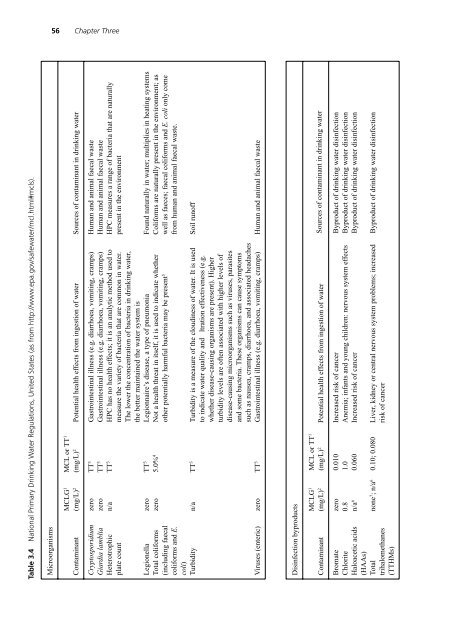Beer : Health and Nutrition
Beer : Health and Nutrition
Beer : Health and Nutrition
You also want an ePaper? Increase the reach of your titles
YUMPU automatically turns print PDFs into web optimized ePapers that Google loves.
Table 3.4 National Primary Drinking Water Regulations, United States (as from http://www.epa.gov/safewater/mcl.html#mcls).<br />
Microorganisms<br />
56 Chapter Three<br />
MCL or TT1 (mg/L) 2 Potential health effects from ingestion of water Sources of contaminant in drinking water<br />
MCLG1 (mg/L) 2<br />
Contaminant<br />
Cryptosporidium zero TT3 Gastrointestinal illness (e.g. diarrhoea, vomiting, cramps) Human <strong>and</strong> animal faecal waste<br />
Giardia lamblia zero TT3 Gastrointestinal illness (e.g. diarrhoea, vomiting, cramps) Human <strong>and</strong> animal faecal waste<br />
Heterotrophic n/a TT<br />
plate count<br />
3 HPC has no health effects; it is an analytic method used to HPC measures a range of bacteria that are naturally<br />
measure the variety of bacteria that are common in water. present in the environment<br />
The lower the concentration of bacteria in drinking water,<br />
the better maintained the water system is<br />
Legionella zero TT3 Legionnaire’s disease, a type of pneumonia Found naturally in water; multiplies in heating systems<br />
Total coliforms zero 5.0%<br />
(including faecal<br />
coliforms <strong>and</strong> E.<br />
coli)<br />
4 Not a health threat in itself, it is used to indicate whether<br />
other potentially harmful bacteria may be present5 Coliforms are naturally present in the environment; as<br />
well as faeces; faecal coliforms <strong>and</strong> E. coli only come<br />
from human <strong>and</strong> animal faecal waste.<br />
Turbidity n/a TT3 Turbidity is a measure of the cloudiness of water. It is used Soil runoff<br />
to indicate water quality <strong>and</strong> ltration effectiveness (e.g.<br />
whether disease-causing organisms are present). Higher<br />
turbidity levels are often associated with higher levels of<br />
disease-causing microorganisms such as viruses, parasites<br />
<strong>and</strong> some bacteria. These organisms can cause symptoms<br />
such as nausea, cramps, diarrhoea, <strong>and</strong> associated headaches<br />
Viruses (enteric) zero TT3 Gastrointestinal illness (e.g. diarrhoea, vomiting, cramps) Human <strong>and</strong> animal faecal waste<br />
Disinfection byproducts<br />
MCL or TT1 (mg/L) 2 Potential health effects from ingestion of water Sources of contaminant in drinking water<br />
MCLG1 (mg/L) 2<br />
Contaminant<br />
Bromate zero 0.010 Increased risk of cancer Byproduct of drinking water disinfection<br />
Chlorite 0.8 1.0 Anemia; infants <strong>and</strong> young children: nervous system effects Byproduct of drinking water disinfection<br />
Haloacetic acids n/a<br />
(HAAs)<br />
6 0.060 Increased risk of cancer Byproduct of drinking water disinfection<br />
Total<br />
none<br />
trihalomethanes<br />
(TTHMs)<br />
7 ; n/a6 0.10; 0.080 Liver, kidney or central nervous system problems; increased Byproduct of drinking water disinfection<br />
risk of cancer

















